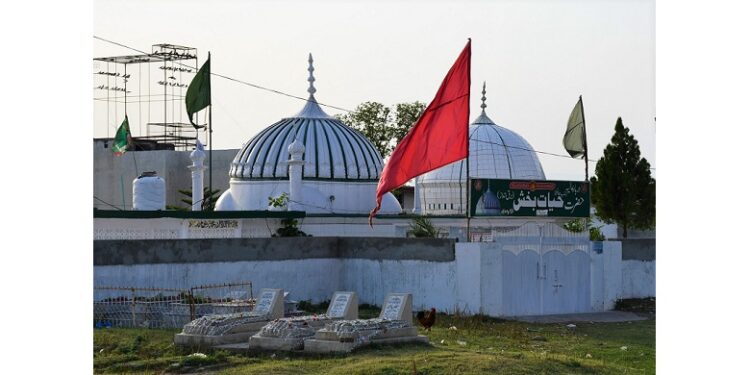
Kirpa became a thriving center of the Naushahiyya Silsila from the third quarter of the 19th century to the second quarter of the 20th century.
Zulfiqar Ali Kalhoro
There are several shrines in villages and towns within the Islamabad Capital territory which belong to various Sufi orders. Much like similar sites in towns, these village shrines are frequently visited by locals, and are revered by a majority of the rural population.
One such revered and frequented village shrine is located in Kirpa, which belongs to Hafiz Hayat Bakhsh Naushahi. Kirpa, which is a historical village, is located about 4 km northeast of Pakhral Chowk near Darwala. The village is also very close to Gulberg Greens in Islamabad. Kirpa village was once a thriving centre of Qadiri Naushahi saints. It is still the most popular shrine complex in Kirpa and neighboring villages in Zone-V in Islamabad.
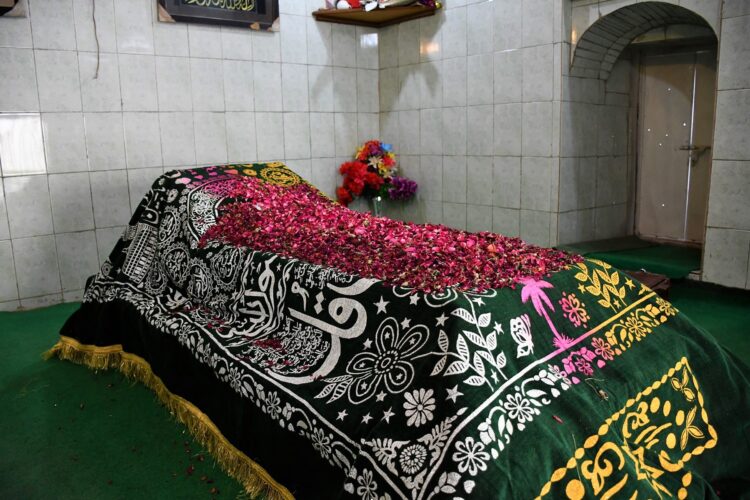
It said that his father Mian Makhan Shah migrated from Gardez in Afghanistan to settle in Aterun village in the Lora area of Abbottabad district. In the village, he married Hashim Bibi who bore him an illustrious son, named Hayat Bakhsh. This Hayat Bakhsh later became an eminent scholar and Sufi saint of Kirpa and neighboring villages in the third quarter of the 19th century. According to Abdul Aziz Pirzada, the author of Anwar Barq Anqaz, Hafiz Hayat Bakhsh was born in 1818 in Aterun village. He obtained his religious education in his village before moving with his mother Bibi Hashim Noor to Gagri village in the Pothohar region in Punjab. Bibi Hashim Noor was a pious lady and an ardent follower of Shah Abdul Latif alias Bari Imam (d.1705). After the death of her husband Mian Makhan Shah, she went to visit the shrine of Bari Imam. After paying homage to Bari Imam, she stayed in Gagri village, located on the left bank of the Soan River near Jinnah Gardens. She spent a few years in Gagri village, where the name and fame of her son Hafiz Hayat Bakhsh spread far and wide.
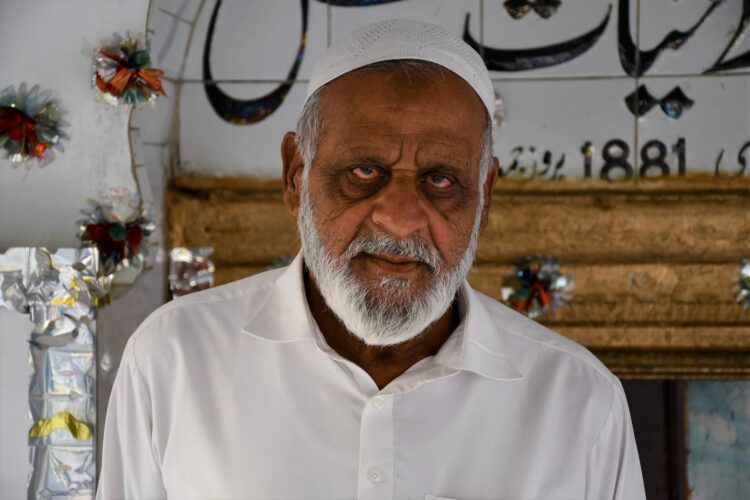
On hearing of the piety of Hafiz Hayat Bakhsh, people of Pind Malkan village visited him and invited him to their village. At their request, Hafiz Hayat Bakhsh visited Pind Malkan. Later they wished that Hafiz should settle in their village permanently and preach there. But Hafiz Hayat Bakhsh did not settle in any village for a long time – before eventually making Kirpa village his permanent abode. He kept moving and preaching in the villages of Kak, Bhinder, Dhamial, Sher Dhamial, Pind Darziyan, Pind Dainyan, Kangota Syedan Darwala and Sihala Khurd. Finally, he settled in Kirpa village from where he continued to preach the Naushahiyya silsila. Kirpa became a thriving centre of the Naushahiyya Silsila from the third quarter of the 19th century to the second quarter of the 20th century. Hafiz Hayat Bakhsh Naushahi and later his daughter and his followers continued to spread Naushahi silsila.
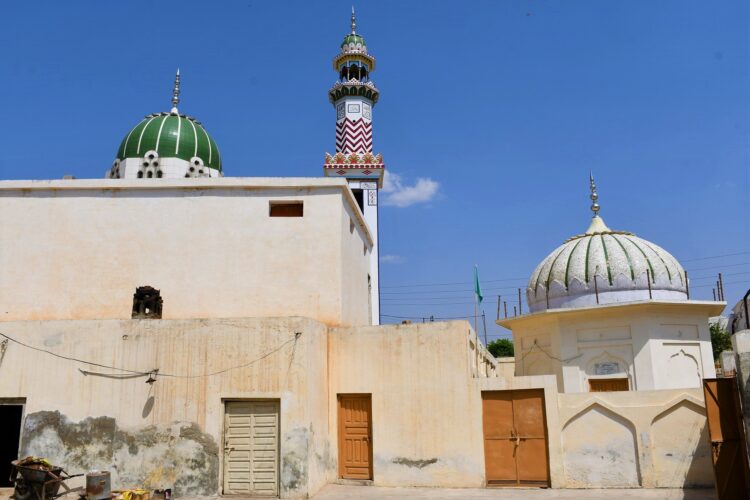
Hafiz Hayat Bakhsh was initiated into the Naushahiyya silsila by Syed Ghulam Shah Naushahi (d.1871). The Naushahiyya, a branch of the Qaidiriyya silsila, was founded by Syed Muhammad Naushah Ganj Bakhsh Qadiri (d.1654). Syed Ghulam Shah, whose shrine is located in Mankrai village in Gujar Khan tehsil, was a deputy (khalifa) of Mian Muhammad Azim Naushahi. The shrine of Mian Muhammad Azim Naushahi is located in Bhadana village in Gujar Khan. He was a deputy of Syed Mir Kalan Gilan Naushahi, who is buried in Rukhia Sharif in Gujar Khan tehsil. Syed Mir Kalan Gilani Naushahi was an eminent deputy of Hafiz Qaimuddin Barqandaz, (d.1765), who was himself a deputy of Pir Muhammad Sachiar Naushahi (d.1707).
Hafiz Hayat Bakshsh Naushahi was both alim (scholar) and Sufi. He mediated at several places around the Soan River, the prominent one was near Mai Qamro mosque. He also mediated and frequently visited the shrine of Mian Ranjha which was located on a hill, 3 km east of Kirpa village. The shrine of Mian Ranjha is popularly known as “Mian Ranjhe ka Chowk.”
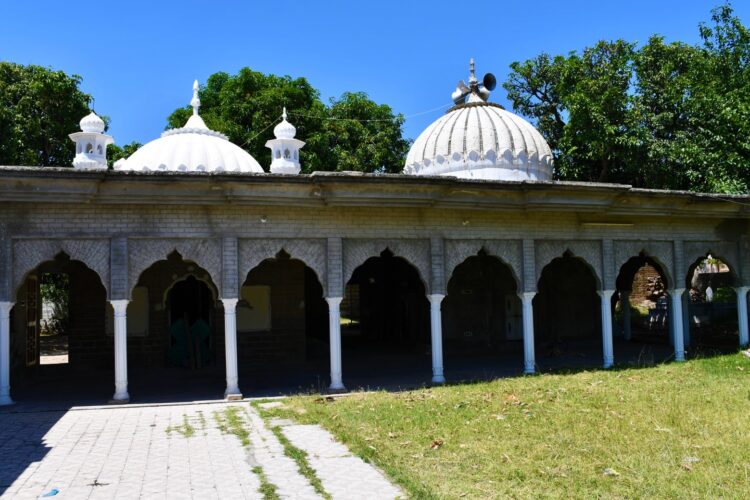
He was also bestowed the title of Barqandaz by his spiritual master, and hence was also popularly known as Hafiz Barqandaz. He became an eminent khalifa (deputy) of Syed Ghulam Shah Naushahi son of Pir Syed Muhammad Ali Shah. He preached the Qadiriyya Naushahiyya silsila in the villages of present-day Islamabad, Rawalpindi and Chakwal, and many people became his deputies and disciples, who continued his missionary work in their respective villages and towns of Pothohar. He died in 1881, leaving behind a number of deputies, disciples and a daughter to continue preaching his teachings.
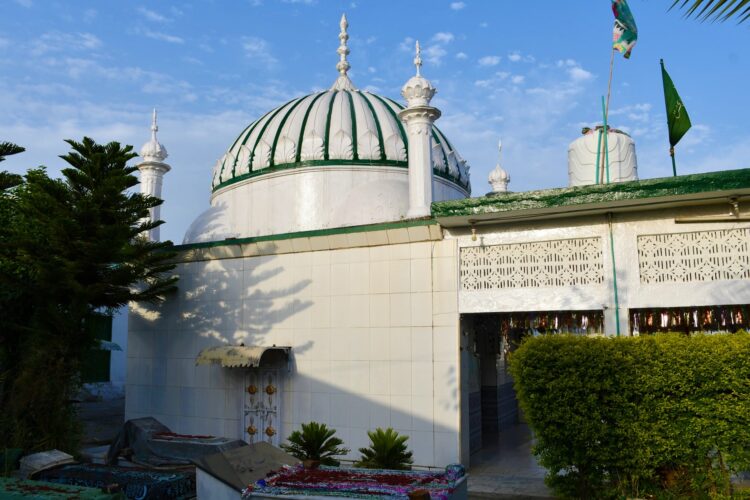
His daughter Syed Noor became Gadi Nashin of Hafiz Hayat Bakhsh’s shrine. It is interesting to note that several female Sufi saints played an important role in the Naushahiyya Silsila, which I discuss in detail in my forthcoming book Female Saints and Shrines in Pothohar. After becoming the Gadi Nashin of his father’s shrine, her first task was to start the construction of a domed structure over the grave of her father. She was also assisted by her mother Karam Noor (d.1924). According to Sanaullah Pirzada, the present Gadi Nashin of the shrine of Hafiz Shah Bakhsh Nauhahi, the construction work on the tomb started in 1881 and was completed in 1890. Syed Noor continued the missionary work of her father and arranged an annual festival at his shrine. She died in 1936 and was buried in the shrine complex of Hafiz Hayat Bakhsh Naushahi. An octagonal dome was constructed over her grave. There are two graves inside the tomb: the first belongs to Syed Noor and the second to Sultan Mehmood son of Mian Mehar, who was a brother of Syed Karam Noor, the wife of Hafiz Hayat Bakhsh Naushahi. After the death of Syed Noor, Sultan Mehmood son of Mian Mehar became the Gadi Nashin of the darbar of Hafiz Hayat Bakhsh. Sahibzada Sultan Mehmood died in 1978 and was succeeded by his younger brother Jan Muhammad Pirzada (d.1993).
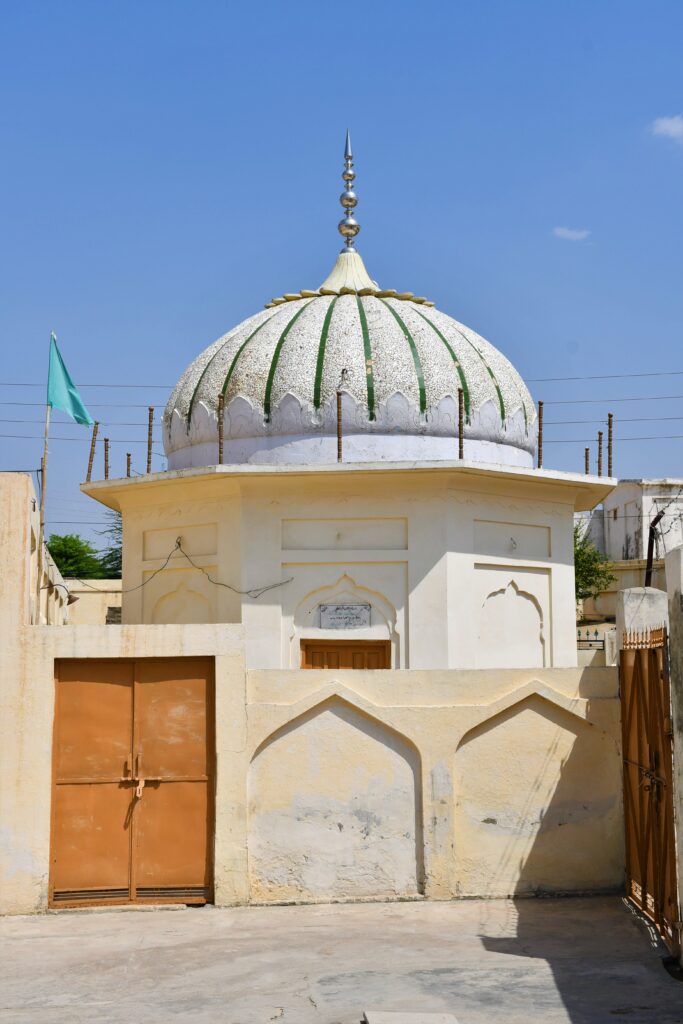
Hafiz Hayat Bakhsh Naushahi had four eminent deputies: Qazi Illahi Bakhskh Qureshi Hashmi, Syed Qasim Ali Shah Bokhari, Syed Gul Hassan Shah Bokhari and Syed Gohar Ali Shah. Apart from his deputies, there were many disciples of Hafiz Barqandaz whose shrines are located in different villages of Islamabad and Chakwal. I have visited each of the shrines of his deputies and disciples – not only in Islamabad but also in Chakwal. And I have interviewed the Gadi Nashins.
An eminent khalifa of Hafiz Barqandaz was Qazi Illahi Bakhsh Qureshi Hashmi, whose shrine is located in Bhagwal village in Chakwal district. He accompanied Hafiz Hayat Bakhsh Naushahi in many of his visits to his deputies and disciples. He was asked by his mentor to establish a khanqah in Bhagwal village to continue preaching the Naushahiyya silsila there. On the instruction of his spiritual master Hafiz Barqandaz, Qazi Illahi Bakhsh Qureshi established his Sufi lodge in Bhagwal and converted many to the Naushahiyya silsila. According to Sahihbzada Ghulam Mustafa, the Gadi Nashin of the shrine of Qazi Illahi Bakhsh Qureshi, Qazi Illahi Bakhsh died in 1896 and was succeeded by his daughter Bhag Bhari. Like Syed Noor, the daughter of Hafiz Hayat Bakhsh Naushahi, Bhag Bhari also continued the missionary work of her father, and many people became her disciples. Bhag Bhari died in 1922 and was succeeded by her sister Noor Bhari. She became the Gadi Nashin of the shrine of Illahi Bakhsh Qureshi. Both Bhag Bhari and Noor Bhari are buried in the tomb of Qazi Illahi Bakhsh Qureshi. Three are three graves in the tomb, having Qazi Illahi Bakhsh Qureshi in the center. On the western side of Qazi Illahi Bakhsh’s grave is buried his daughter Noor Bhari while on the eastern side is his eldest daughter Bhag Bhari.
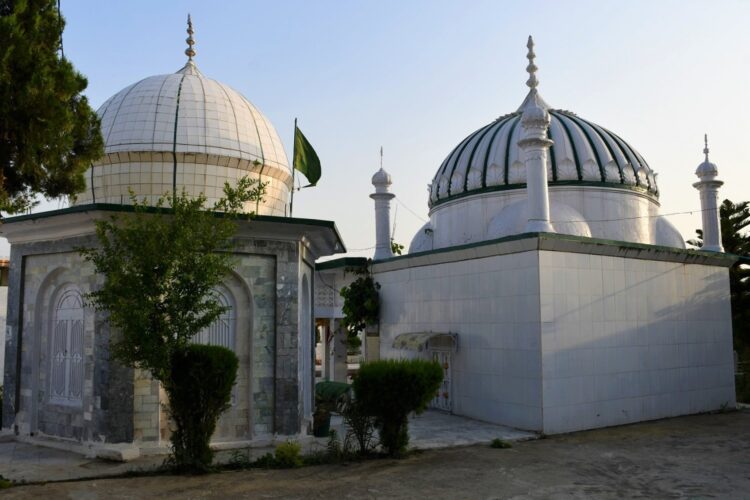
Another leading deputy of Hafiz Hayat Bakhsh Naushahi was Syed Qasim Ali Shah Bokhari whose shrine complex is located in Chirah village, which is located about 5 km northeast of Kirpa village. The shrine complex of Syed Qasim Ali Shah Bokhari comprises a mosque, his tomb and his son Syed Jamal Shah Bokhari’s tomb (d.1960). According to Syed Kosar Ali Shah Bokhari, the Gadi Nashin of the shrine of Syed Qasim Ali Shah Bukhari, Syed Qasim Ali Shah Bokhari, died in 1921 and was succeeded by his son Syed Jamal Shah Bokhari.
Another prominent deputy of Hafiz Hayat Bakhsh was Syed Gul Hassan Shah Bokhari (1895). The shrine of Syed Gul Hassan Shah Bokhari is located in Pind Daiyan village near Jinnah Gardens, Islamabad. He also preached the Naushahiyya Silsila – not only in his village but also in other villages of Pothohar.
Syed Gohar Ali Shah was another prominent deputy of Hafiz Hayat Bakhsh Naushahi. The grave of Syed Gohar Ali Shah is located in the graveyard of Syed Pehlwan Shah Kazmi in Ratti Kassi on the main road that connects Darwala village to Bhimbar Trar village. As per the inscription on his grave, Syed Gohar Ali Shah died in 1924.
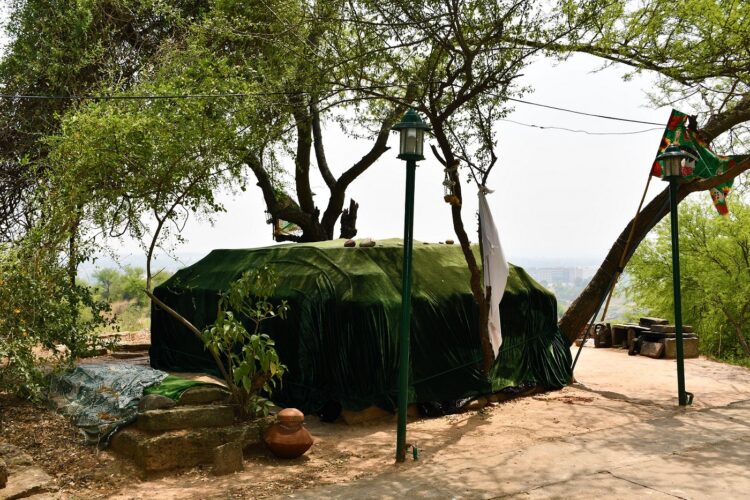
Apart from prominent deputies, the shrines of his disciples are also located in different villages in Islamabad. Two of his leading disciples were Sain Aku alias Kala Faqir and Sain Baq. Sain Aku was a very dear disciple of Hafiz Hayat Bakhsh Naushahi. I asked many people about the exact location of his shrine, but nobody knew about it. I kept asking and looking for his grave in and around Pind Malkan for two days and finally found his grave at Dhok Najaf, which is now situated in the OPF housing scheme. The grave of Sain Aku alias Kala Faqir is located on a Dheri (hill) and is covered with green chadar. This is the family graveyard of Sain Aku. The grave of his son Sain Najaf, after whom the village is named, is located east of the grave of Sain Aku. As per the inscription on his grave, Sain Najaf died in 1964.
Another prominent disciple of Hafiz Hayat Bakhsh Naushahi was Sain Bak (d.1929) whose shrine is located in Kangota Syedan village on Japan Road near the Naval Anchorage. The deputies and disciples of Hafiz Hayat Bakhsh Naushahi spread his message of peace, love and tolerance in various villages and towns of Pothohar.
________________
 Dr. Zulfqar Ali Kalhoro, an anthropologist, has authored 12 books including ‘Symbols in Stone: The Rock Art of Sindh’, ‘Perspectives on the art and architecture of Sindh’, ‘Memorial Stones: Tharparkar’ and ‘Archaeology, Religion and Art in Sindh’. He may be contacted at: zulfi04@hotmail.com
Dr. Zulfqar Ali Kalhoro, an anthropologist, has authored 12 books including ‘Symbols in Stone: The Rock Art of Sindh’, ‘Perspectives on the art and architecture of Sindh’, ‘Memorial Stones: Tharparkar’ and ‘Archaeology, Religion and Art in Sindh’. He may be contacted at: zulfi04@hotmail.com
Courtesy: The Friday Times Lahore